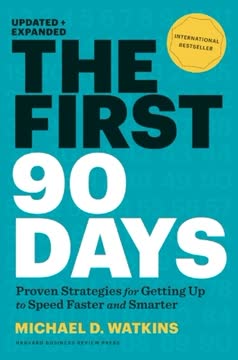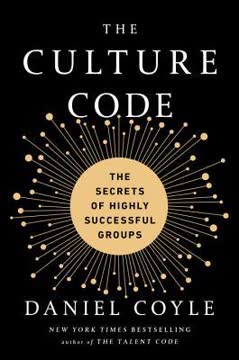Key Takeaways
1. Bring Your Human to Work: Honor Relationships for Success
A human workplace honors relationships.
Build genuine connections. In today's digital age, it's crucial to create a workplace that values authentic human interactions. This means fostering an environment where employees feel comfortable bringing their whole selves to work, leading to increased engagement, productivity, and overall job satisfaction.
Prioritize relationships at all levels. Honoring relationships extends beyond employee-to-employee interactions. It includes relationships with customers, partners, and the community at large. By focusing on building strong, meaningful connections throughout the organization, companies can create a more resilient and successful business model.
Key aspects of a human workplace:
- Encourages open communication
- Values empathy and emotional intelligence
- Promotes work-life balance
- Recognizes individual contributions
- Fosters a sense of belonging and community
2. Align Company Values with Authentic Actions and Communication
Be real, and encourage other people to be real.
Define and live your values. Successful companies don't just have values written on their walls; they integrate them into every aspect of their business. This alignment between stated values and actual behavior creates a strong, authentic culture that resonates with employees and customers alike.
Communicate authentically. When companies speak in a genuine, human voice, they build trust and credibility. This applies to both internal and external communications, from company-wide emails to marketing campaigns.
Ways to align values with actions:
- Include values in decision-making processes
- Recognize and reward behaviors that exemplify company values
- Regularly assess and update values to ensure relevance
- Train leaders to model values-driven behavior
- Incorporate values into hiring and performance evaluations
3. Play the Long Game: Embrace Sustainable Business Practices
True sustainability is a state of mind.
Think beyond short-term gains. Sustainable business practices involve considering the long-term impact of decisions on people, the environment, and the company itself. This approach leads to more resilient organizations and better outcomes for all stakeholders.
Invest in the future. Companies that prioritize sustainability often see benefits in employee retention, customer loyalty, and overall business performance. This includes investing in employee development, environmentally friendly practices, and community engagement.
Key aspects of sustainable business practices:
- Implement environmentally responsible policies
- Prioritize employee well-being and development
- Engage in ethical supply chain management
- Foster diversity and inclusion
- Contribute positively to local communities
4. Find the Sweet Spot Between Technology and Human Connection
Match the medium to the message.
Balance digital efficiency with human touch. While technology can streamline processes and improve communication, it's essential to use it thoughtfully. Finding the right balance ensures that technology enhances rather than replaces meaningful human interactions.
Choose the right communication channels. Different messages require different mediums. High-stakes conversations often benefit from face-to-face interaction, while quick updates might be suitable for digital platforms. Understanding when to use each channel is crucial for effective communication.
Strategies for finding the sweet spot:
- Implement technology that supports, not replaces, human interaction
- Train employees on effective digital communication
- Create opportunities for in-person collaboration
- Use data-driven insights to improve customer experiences
- Regularly assess and adjust technology use based on outcomes
5. Mind Your Meetings: Purpose, Presence, and Protocols
If you're coming to the meeting, you must be there, in body and mind.
Ensure meetings have clear objectives. Every meeting should have a defined purpose and expected outcomes. This focus helps prevent wasted time and increases engagement among participants.
Encourage full presence. Implement protocols that minimize distractions and encourage active participation. This might include no-device policies or specific roles for meeting attendees.
Tips for effective meetings:
- Create and distribute agendas in advance
- Start and end on time
- Assign roles (e.g., facilitator, note-taker)
- Limit meeting size to necessary participants
- Follow up with action items and deadlines
- Regularly evaluate meeting effectiveness and adjust as needed
6. Prioritize Employee Well-Being for a Thriving Workplace
We believe in the idea of self-awareness and self-management and people really showing up in a responsible way.
Holistic approach to wellness. Employee well-being encompasses physical, mental, and emotional health. Companies that prioritize all aspects of wellness create more engaged, productive, and loyal employees.
Create supportive policies and environments. This includes offering flexible work arrangements, mental health resources, and physical wellness programs. A supportive workplace culture encourages employees to take care of themselves and each other.
Components of a comprehensive well-being program:
- Flexible work schedules
- Mental health support and resources
- Physical fitness opportunities or subsidies
- Stress management workshops
- Healthy food options in the workplace
- Regular check-ins on employee satisfaction and needs
7. Give Back: Inspire Employees Through Meaningful Social Impact
Your people will be more inspired to come to work every day if they believe in what you're doing.
Align social impact with company values. When companies engage in philanthropic efforts that align with their mission and values, it creates a sense of purpose and pride among employees.
Involve employees in giving back. Offering opportunities for employees to participate in volunteer work or contribute to charitable causes can increase job satisfaction and foster a sense of community within the organization.
Ways to incorporate social impact:
- Implement company-wide volunteer days
- Match employee charitable donations
- Partner with local nonprofits
- Offer pro-bono services in your area of expertise
- Create products or services that address social issues
8. Disconnect to Reconnect: Encourage Work-Life Balance
If you're not taking care of yourself or your family, you're not taking care of business.
Promote intentional disconnection. Encourage employees to take time away from work to recharge and focus on personal life. This leads to increased productivity and creativity when they return to work.
Lead by example. Leaders should model healthy work-life balance by taking vacations, avoiding after-hours communications, and respecting employees' personal time.
Strategies for promoting work-life balance:
- Implement "no email" hours or days
- Offer generous paid time off policies
- Encourage use of vacation days
- Provide flexible work arrangements
- Recognize and reward efficiency rather than long hours
- Offer workshops on time management and stress reduction
9. Design Spaces That Foster Collaboration and Creativity
We shape our buildings; thereafter they shape us.
Intentional space design. The physical workspace plays a crucial role in how employees interact and perform. Design spaces that reflect company values and encourage desired behaviors.
Balance collaboration and focus. Create a mix of open collaborative areas and quiet spaces for focused work. This allows employees to choose the environment that best suits their current task.
Elements of effective workspace design:
- Flexible furniture and layouts
- Dedicated areas for different work styles (collaborative, focused, casual)
- Natural light and plants
- Technology-enabled meeting spaces
- Comfortable break areas
- Visual representations of company culture and values
10. Personalize Professional Development for Employee Growth
We focus on empathy, strength spotting, self-awareness, and self-management, so that people can show up more authentically.
Tailor development opportunities. Recognize that each employee has unique strengths, interests, and career goals. Offer a variety of development options to cater to individual needs.
Encourage continuous learning. Foster a culture where learning is valued and supported. This can include formal training programs, mentorship opportunities, and support for pursuing personal interests that may benefit the company.
Approaches to personalized professional development:
- Regular career development conversations
- Skill-based training programs
- Cross-functional project opportunities
- Mentorship and coaching programs
- Support for attending conferences or industry events
- Encouragement of side projects or "passion work"
11. Express Gratitude: The Power of Saying Thank You
Saying thank you to colleagues makes them "feel happier and more fulfilled".
Cultivate a culture of appreciation. Regularly expressing gratitude can significantly impact employee morale, engagement, and retention. Make recognition a part of daily work life.
Personalize recognition. Tailor expressions of gratitude to individual preferences and accomplishments. This shows that the appreciation is genuine and thoughtful.
Ways to express gratitude in the workplace:
- Implement peer-to-peer recognition programs
- Celebrate team and individual achievements publicly
- Write personal thank-you notes
- Offer small rewards or tokens of appreciation
- Include gratitude practices in team meetings
- Recognize efforts and progress, not just outcomes
Human Workplace Generator: Bringing Your Human to Work by Erica Keswin
This transformative summary of "Bring Your Human to Work" by Erica Keswin highlights the importance of creating a workplace that values genuine human connections, authenticity, and relationships. By implementing these key takeaways, organizations can foster a more engaged, productive, and fulfilling work environment that benefits both employees and the bottom line.
The book emphasizes the need to align company values with actions, embrace sustainable practices, balance technology with human interaction, and prioritize employee well-being. It also stresses the importance of effective meetings, giving back to the community, encouraging work-life balance, and designing spaces that promote collaboration and creativity.
Furthermore, Keswin underscores the value of personalized professional development and the power of expressing gratitude in the workplace. By incorporating these principles, companies can create a truly human workplace that attracts and retains top talent, enhances productivity, and ultimately drives business success.
As the workplace continues to evolve, the principles outlined in this book provide a roadmap for organizations to adapt and thrive by putting their people first and fostering a culture of genuine human connection.
Last updated:
FAQ
What's "Bring Your Human to Work" about?
- Humanizing the Workplace: The book focuses on creating a workplace that is inclusive, meaningful, and inspires creativity and innovation by bringing human elements into work environments.
- Practical Strategies: Erica Keswin provides ten surefire ways to design a workplace that is good for people and great for business, with the potential to change the world.
- Real-Life Examples: The book is filled with stories and examples from companies that have successfully implemented human-centric practices.
- Balancing Technology and Humanity: It emphasizes finding the sweet spot between using technology and maintaining human connections.
Why should I read "Bring Your Human to Work"?
- Improve Workplace Culture: The book offers actionable strategies to enhance workplace culture, making it more human-centered.
- Boost Employee Engagement: By implementing the book's strategies, you can increase employee engagement and satisfaction.
- Enhance Business Success: The book argues that when people thrive, businesses thrive, leading to better overall success.
- Inspiration and Guidance: It provides inspiration and guidance for leaders, managers, and employees looking to create a more purpose-driven work environment.
What are the key takeaways of "Bring Your Human to Work"?
- Honor Relationships: The central theme is honoring relationships in everything you do at work, from meetings to professional development.
- Be Real: Authenticity is crucial; companies should know their values and communicate them clearly.
- Balance Tech and Connect: Find the right balance between using technology and maintaining personal connections.
- Well-Being and Sustainability: Focus on employee well-being and sustainable work practices to ensure long-term success.
What are the best quotes from "Bring Your Human to Work" and what do they mean?
- "When people thrive, business thrives." - This quote by Arianna Huffington encapsulates the book's message that prioritizing employee well-being leads to business success.
- "A human workplace honors relationships." - This emphasizes the importance of building and maintaining strong relationships in the workplace.
- "Bringing your human to work is not rocket science, but that doesn’t mean it’s easy." - This highlights that while the concept is simple, it requires effort and commitment to implement effectively.
- "Culture is important, often thought to be number one on the list of critical factors in building a successful business." - This underscores the significance of workplace culture in achieving business success.
How does Erica Keswin define a "human workplace"?
- Honoring Relationships: A human workplace is one that honors relationships in all aspects of work, from communication to decision-making.
- Authenticity and Values: It is characterized by authenticity, where companies know and live by their values.
- Balance with Technology: A human workplace finds the right balance between leveraging technology and maintaining personal connections.
- Focus on Well-Being: It prioritizes employee well-being and sustainable work practices.
What are the ten surefire ways to design a human workplace according to Erica Keswin?
- Be Real: Speak in a human voice and know your brand's values.
- Play the Long Game: Focus on sustainability and intentional work practices.
- Find the Sweet Spot: Balance technology and human connection.
- Mind Your Meetings: Ensure meetings have purpose, presence, and protocols.
- Well-Being at Work: Prioritize employee wellness and holistic well-being.
- Give Back: Encourage social responsibility and community engagement.
- Disconnect to Reconnect: Promote work-life balance and disconnection from work.
- Space Matters: Design workspaces that foster connection and collaboration.
- Take Professional Development Personally: Empower employees to grow personally and professionally.
- Say Thank You: Cultivate a culture of gratitude and recognition.
How does "Bring Your Human to Work" suggest balancing technology and human connection?
- Match Medium to Message: Use the appropriate communication method based on the stakes of the message.
- High-Tech for Human Touch: Automate mundane tasks to free up time for personal interactions.
- Set Protocols: Establish guidelines for when and how to use technology to enhance, not hinder, human connections.
- Prioritize Relationships: Ensure that technology serves to strengthen relationships rather than replace them.
What role does authenticity play in "Bring Your Human to Work"?
- Core Principle: Authenticity is a core principle in creating a human workplace, where companies are true to their values.
- Brand Identity: Companies should communicate their brand's values authentically to employees and customers.
- Employee Engagement: Authenticity leads to greater employee engagement and satisfaction.
- Customer Trust: Being authentic helps build trust with customers and enhances brand loyalty.
How does "Bring Your Human to Work" address employee well-being?
- Holistic Approach: The book advocates for a holistic approach to well-being, including physical, mental, and emotional health.
- Intentional Practices: Implement intentional work practices that support employee well-being, such as flexible schedules and wellness programs.
- Sustainability: Focus on sustainable work practices that promote long-term health and productivity.
- Recognition and Support: Provide recognition and support to employees to enhance their overall well-being.
What are some examples of companies successfully implementing human-centric practices from "Bring Your Human to Work"?
- JetBlue: Known for its strong values and focus on employee and customer relationships.
- Lyft: Emphasizes human connections and community through its core values.
- Patagonia: Offers on-site childcare and other family-friendly policies to support employee well-being.
- SoulCycle: Uses a pin program to recognize and celebrate employees who embody company values.
How can leaders implement the strategies from "Bring Your Human to Work"?
- Lead by Example: Leaders should model the behaviors and values they want to see in their organization.
- Communicate Clearly: Clearly communicate the company's values and expectations to all employees.
- Empower Employees: Empower employees to take ownership of their roles and contribute to the company's culture.
- Provide Support: Offer support and resources for employees to grow and thrive in their roles.
What impact can "Bring Your Human to Work" have on a business?
- Increased Engagement: Implementing the book's strategies can lead to higher employee engagement and satisfaction.
- Improved Culture: A focus on human-centric practices can enhance workplace culture and make it more inclusive and meaningful.
- Business Success: Prioritizing people and relationships can lead to greater business success and innovation.
- Positive Change: The book's strategies have the potential to create positive change in the workplace and beyond.
Review Summary
Bring Your Human to Work receives mixed reviews, with an average rating of 3.71/5. Readers appreciate the practical examples and insights on creating a more humane workplace. Many find it inspiring and thought-provoking, praising the focus on employee well-being and company culture. However, some criticize the book for being repetitive, lacking depth, or offering common-sense advice. Post-pandemic, certain chapters are considered less relevant. Overall, it's seen as a useful resource for managers and HR professionals, though opinions vary on its originality and applicability.
Similar Books








Download PDF
Download EPUB
.epub digital book format is ideal for reading ebooks on phones, tablets, and e-readers.




